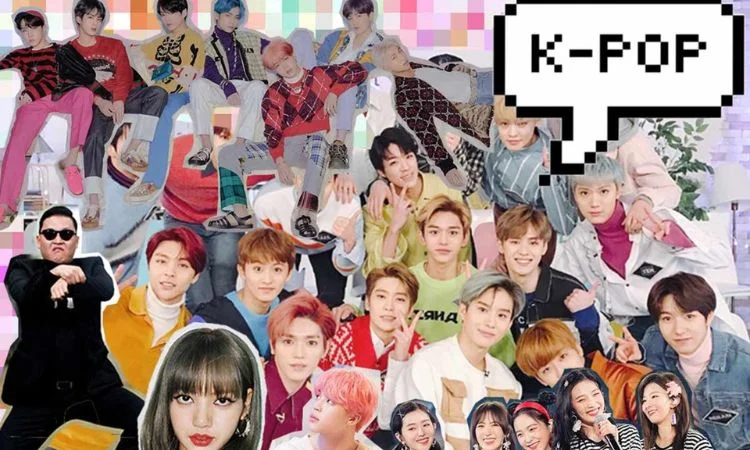Ever heard of BTS? Or Blackpink? Well, you get to hear these names only from fans who have a crazy liking for these famous Korean music groups. K-pop which usually means Korean popular music is an admired form of music, that emerged from South Korea as a part of its culture. These band groups have a strong fanbase or ”army’’ in different parts of the world.
It comprises various genres, styles, and elements of music from all over the world. In contrast to other forms of music, K-pop is something new and different. It includes various styles such as styles such as hip-hop, rock, jazz, and electronic dance in their music.
It first came into existence in the year 1990 and became quite popular in the 2000s. This pop music is dominated by western culture and mostly by American Pop Culture. Different genres are used to produce distinct concepts. The lyrics of many K-pop songs contain English phrases which are used as a trend by artists to exhibit their Vocab and fluency in English.

The very first group to perform on T.V. was the Seo Taiji and Boys in the year 1992. The present-day kind of genre originally called “rap” originated with the genesis of hip hop this boy band group. Trying different music styles and genres and foreign musical elements has helped South Korea to reorganize and update its contemporary music scene. It was the S.M. Entertainment that led to the evolution of the most loved “Idol groups”.
The current k-pop “idol” music advanced into a subculture that got together huge fandoms of teenagers and youngsters. Even though K- pop usually alludes to South Korean popular music and the related industry, many consider it to be an overall genre that portrays a wide range of audio and visual segments. Fans are obsessed with the blend of different music, distinct dance moves, and Fashionable brilliant outfits. Sometimes skilled artists are offered contracts at a very young age by agencies.
Along with popularity, K-pop has also faced a lot of criticism from some renowned music critics regarding its identity ever since its dominance. It has been defined as an industrial label that is mainly intended to encourage the national brand in the global market from the start. They’ve also been criticized by journalists who recognize the music as imitative and copied. Some have also been blamed for reproducing western music besides the other forms of musical art.
Dance is an indispensable part of K-pop. Their keen interest in dance is seen when the singers often switch their positions as they sing and dance swift movements in synchronization which is a tactic often termed as “formation changing”. K-pop Choreography often incorporates a form of dance called the “point dance” which is made up of hooking and reiterating movements that sync with the lyrics of the song.
The training and grooming necessary for K-pop idols to flourish in the industry and to dance gracefully is extraordinary. Training centers instigate the dance skills of youth so as help them to give try at becoming an idol. The entertainment industry labels are very choosy so a few make it to the stage.
The acquisition of Western style expanded the fashion worn by the first K-pop boy band – Seo Taiji and Boys who had taken on a hip-hop aesthetic. Many K-pop acts have adopted the same style of fashion as that of the Seo Taiji Boys which includes lively streetwear like oversized T-shirts and sweatshirts, baggy pants, and sportswear along with other accessories such as baseball cap which they typically wear backward, do-rags and bucket caps. Fans are inspired by such cool outfits and have tried coordinated costumes that reflect the K-pop style. Fashion Trends enclosed within the K-pop community have pondered on diversity and distinction.
K-pop artists are often called idols or idol groups. These groups generally have a leader who happens to be the eldest or the most experienced among the other members and speaks on behalf of the group. The youngest member of the group is referred to as maknae which is used to distinguish him from the leader if they happen to share a common name and spelling.
It is often believed that women constitute most of the fandom. But an interview revealed that male fans from different countries had also followed these idols who had helped them to gain a better perception of the abstract of masculinity. Sometimes fan clubs take part in charity events to support their idols, by buying bags of ‘fan rice’ so as to show support. These rice bags are then donated to people who are in need.
They also have a unique feature called “fan chant”. Whenever a group releases its new songs, chants that generally contain the group member’s name are performed by audiences at live concerts during non-singing parts of the song.
Conclusion
There is no other culture that is as popular as K-pop Industry and having a strong fan base has added on to its advantages. Their content is incomparable. It stands out in all forms of art, be it music, dance, or drama. They are showered with love by their fandoms which is truly respected by the idols. After all, what makes anything famous are the fans who support them and shape its future.















